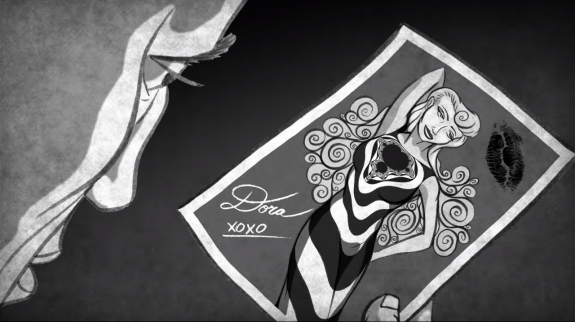
A fractal film noir: Using narrative to help teach math

The TED-Ed Lesson “The case of the missing fractals” isn’t just an introduction to the immensely intricate and beautiful world of fractal geometry; it’s also a fully realized film noir short complete with plot, drama and its fair share of ridiculous puns. This educational and cinematic creation is the product of a TED-Ed dream team, with writing by veteran TED-Ed Educators George Zaidan and Alex Rosenthal and animation by our own TED-Ed Animation Producer Jeremiah Dickey. We met up with this trio to talk about the process of approaching an educational lesson with a narrative eye.
Alex and George, how did you come up with the idea for the lesson? Why did you want to cover fractals?
Alex Rosenthal: I pretty much started working on this when the previous lesson that George and I worked on together, which was about Flatland, premiered. And a lot of our thinking was informed by what we felt worked with that because it also used this really bizarre, mind-blowing geometry.
So we had talked about a number of different ideas, and we picked fractals because it was another topic where we get this really bizarre revelation about how the world works by diving into geometry. And there is the opportunity to create really beautiful visuals for fractals — they really shine when you look at them, so they were a natural hook for the visual medium.
How did you decide you wanted to make this into a narrative piece, as opposed to a more straightforward lesson?
AR: I go in looking for the narrative. My background is in theater and in film, and I’m always looking for those ways to enter in, especially when it comes to math and science. Not just reporting it but to tell the story. Because I think a good story and characters can help get you in and give you an empathetic, intuitive sense of the subject more than if it was just the pure information.
Why did you choose film noir as the genre?
George Zaidan: Well, Alex did write a non-noir version. He wrote a straight expository version of the fractals script, and then later he sent me this email saying, “I was in the shower, and I had an idea for how we might do this narratively.” So he wrote the noir version of it, and it was just so fun, and there were so many Easter eggs for the math and the noir genre that we both just were like, “Wow. This is great. This is really working.”
AR: Also, noir has a really beautiful sense of using language. The noir narrative style is very reliant on puns, and there are a lot of double- and triple-meanings. And that appealed to me — it seemed a nice parallel to the structure of fractals. You know, the deeper you go into them, the more you find the same thing. Or you find just these layers upon layers that are almost tied to the same thing. The density of the language and the density of the geometry felt connected in such a way that seemed to really work.

An email exchange between Alex and George in the early planning stages

The final version of the “fractal femme” fatale mentioned in the email
Jeremiah, you handpicked this lesson to work on. What made you want to animate it?
Jeremiah Dickey: Well the lesson was just written so well, the first time I read it I think the story played out in my head almost exactly how it turned out on the screen…all except the fractals – those I had to research to actually wrap my head around. But I really loved the script that George and Alex wrote, and basically really just wanted to see it done right. Also, cinephile that I am, I have a love for film noir that goes all the way back to film school, but I’ve never actually had a real opportunity to work in the genre. So, I jumped at the chance.
Alex and George, what did you think of the animation?
AR: Part of what I loved — something Jeremiah really brought to it — is that there’s something fundamentally otherworldly about fractals and yet of this world. The history of fractals is that they were actually a way of understanding nature better. And you find fractals all over nature because nature works in the same way fractals do, in that they adhere to a set of rules that tend to iterate all the way down, repeatedly, until you get these beautiful, massive, infinite symmetries that you see everywhere from ferns to rivers to trees. And the style that Jeremiah brought to it has a very fine, nuanced sense that captures the tension between Platonic geometry and fractal geometry, the geometry of order and the geometry of chaos. And I think that really comes out in the mood and the environment that Jeremiah created.

Manny Brot, PI, climbs the Platonic peak
It sounds like you all knew quite a bit about the noir style before diving into it. Did you have to do any additional research when you did decide this was going to be the direction you took?
AR: I jumped into some noir dictionaries. I think getting the use of metaphor right is one of the main tells of noir, and so I read a lot of examples of that. George, did you watch The Maltese Falcon while you –
GZ: I did, yeah. I absolutely watched The Maltese Falcon. I watched that, and I actually took a — I haven’t told anyone this yet — but I said, well, look, I really want to do the voice because this is really different and new. And I was going to do the voice for Manny, and then either Alex or Jeremiah was going to do the voice for Sierpinski. But in the end, for travel reasons, I contributed both voices. But before we had decided, I took an acting class with my buddy, who told me, “All right, here’s the movies you need to watch. Here’s a radio story you need to listen to.” And we did an hour with Alex’s script, figuring out how to make it really sound like a noir detective.
Well, I had no idea that you read both of the roles. So, great work! Jeremiah, what was your research process?
JD: My process usually involves soaking up as much information and visual reference as I can about the subject matter without thinking too much about it, and then just seeing what comes out. True film noir usually has an element of weirdness that sets it apart from the more typical crime drama of the era, and the roots of that really come from German expressionism, brought over to Hollywood by German filmmakers fleeing Europe in the years leading up to WWII. So with this in mind, I spent time looking at German artists like Otto Dix, Käthe Kollwitz, George Grosz. Also American comic book artists of the era who did pulp/crime comics, Mort Meskin, Alex Toth. I also watched a lot of films, 2 or 3 a night, including many shot by a cinematographer named John Alton. There are also some subtle homages to other films in there. One not so subtle one would be Alfred Hitchcock’s Vertigo, which maybe isn’t strictly a noir film, but it’s one of my favorites.
In addition to the art side, I also read up on Benoît B. Mandlebrot, the late revolutionary mathematician who coined the term fractal, and whom the main character of the lesson is named after. There is a great documentary by Arthur C. Clarke (of 2001: A Space Odyssey fame) on Mandlebrot and his work called The Colors of Infinity, which you can find on YouTube. I got my hands on a copy of Mandlebrot’s book The Fractal Geometry of Nature, and I wish I could say I read it, but I didn’t. I did study the pictures intensely, though, and used quite a few of them at the end of the lesson.

A stack of Jeremiah’s drawings from the lesson
What was your favorite part of working on the lesson, and what was the hardest part?
AR: For me, my favorite part was working with these guys because I think it was a “whole is greater than the sum of its parts” sort of situation. Writing with George, we have a very complementary skill set, and I think in passing the scripts back and forth, we were able to create something a lot stronger than what I would have been created on my own. And seeing what Jeremiah did with it was really wonderful and satisfying.
The hardest part, I think, was I struggled a lot with is that “Is the narrative overwhelming the educational material?” We put a lot into the subtext in the hope that people would get there watching it and thinking about it. And I’m very curious to hear people’s impression of how it turned out.
GZ: So I think my favorite thing was basically the same as Alex’s. I know for sure that working together we created a script that would have been far better than anything that I could’ve done myself.
And so that was a big part. But the hardest part was the voiceover. Because I’m not a trained actor by any stretch. My degree’s in chemistry. No formal language training. So going from the regular style of just, “I’m teaching something to you” to you know, “I’m totally hard-boiled and doing my best to solve the case of the missing triangle” was really, really difficult.

Animation work in progress stages
JD: Usually the funnest part of the job for me is figuring out how to visualize the lesson, but in this case George and Alex really had spelled a lot of it out there already on the page. So, I really enjoyed making the most out of the time I could spend working on the look and feel of it and figuring out what constraints I would work within. I knew I wanted to do it in black and white, even the animation of the Mandlebrot set at the end, which you usually see rendered in all sorts of psychedelic colors.
Of all the fractals, the Mandlebrot set was actually the easiest to animate, as the computer was able to do all the work (it took several hours to render). The Sierpinski Triangle and the Koch Snowflake were the biggest challenges. I had to basically figure out and create one iteration of each transformation using 2D computer graphics and then composite or assemble a never-ending loop of the transformations happening for the whole of each fractal. It got more complicated when we had to zoom in to illustrate exactly what was happening. Still, just like doing the math involved in describing a piece of infinite geometry, all you had to do was get the one iteration right, and the whole motion graphic would seamlessly repeat itself when assembled properly. The hard part was just getting to that point.



